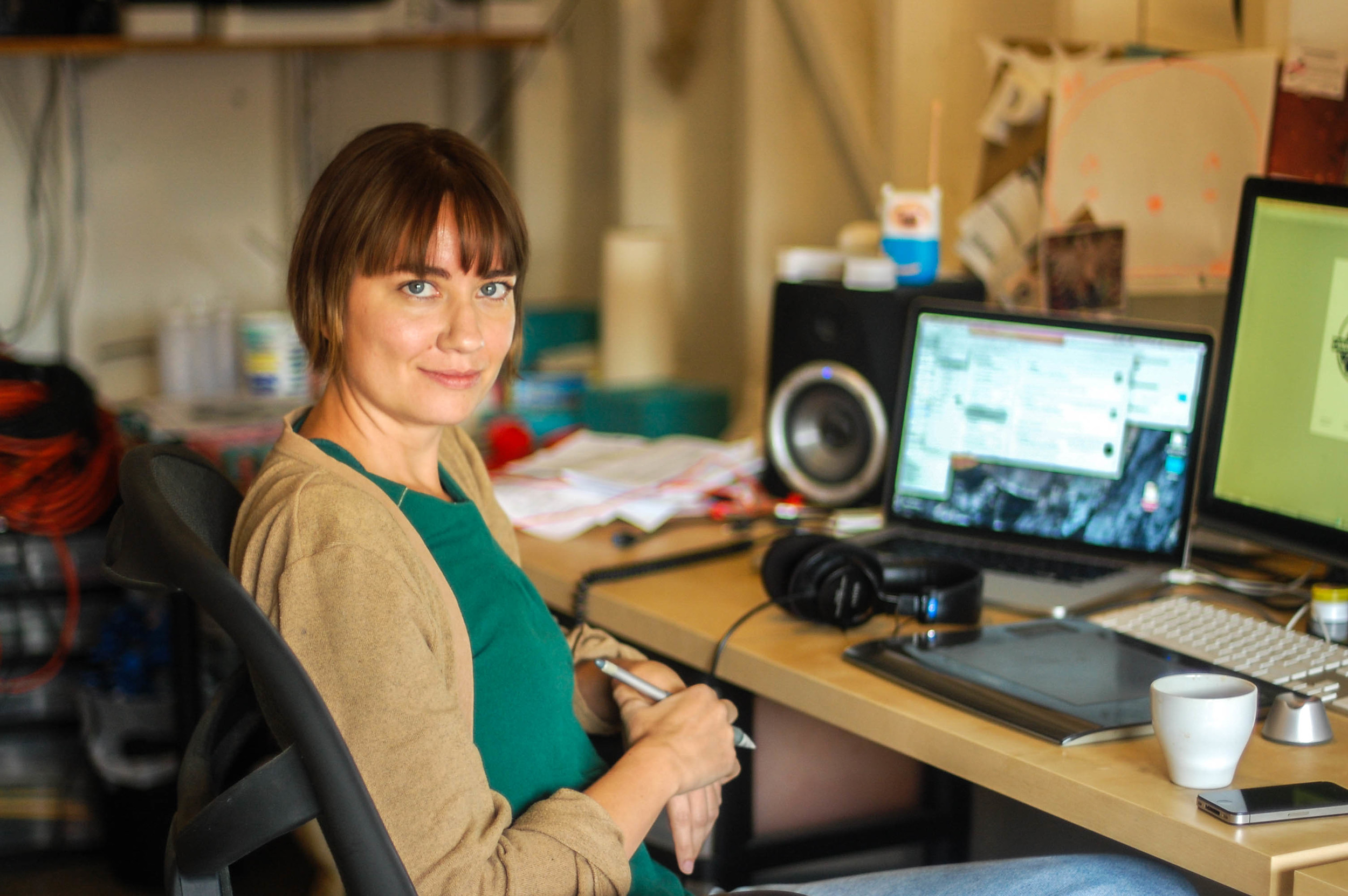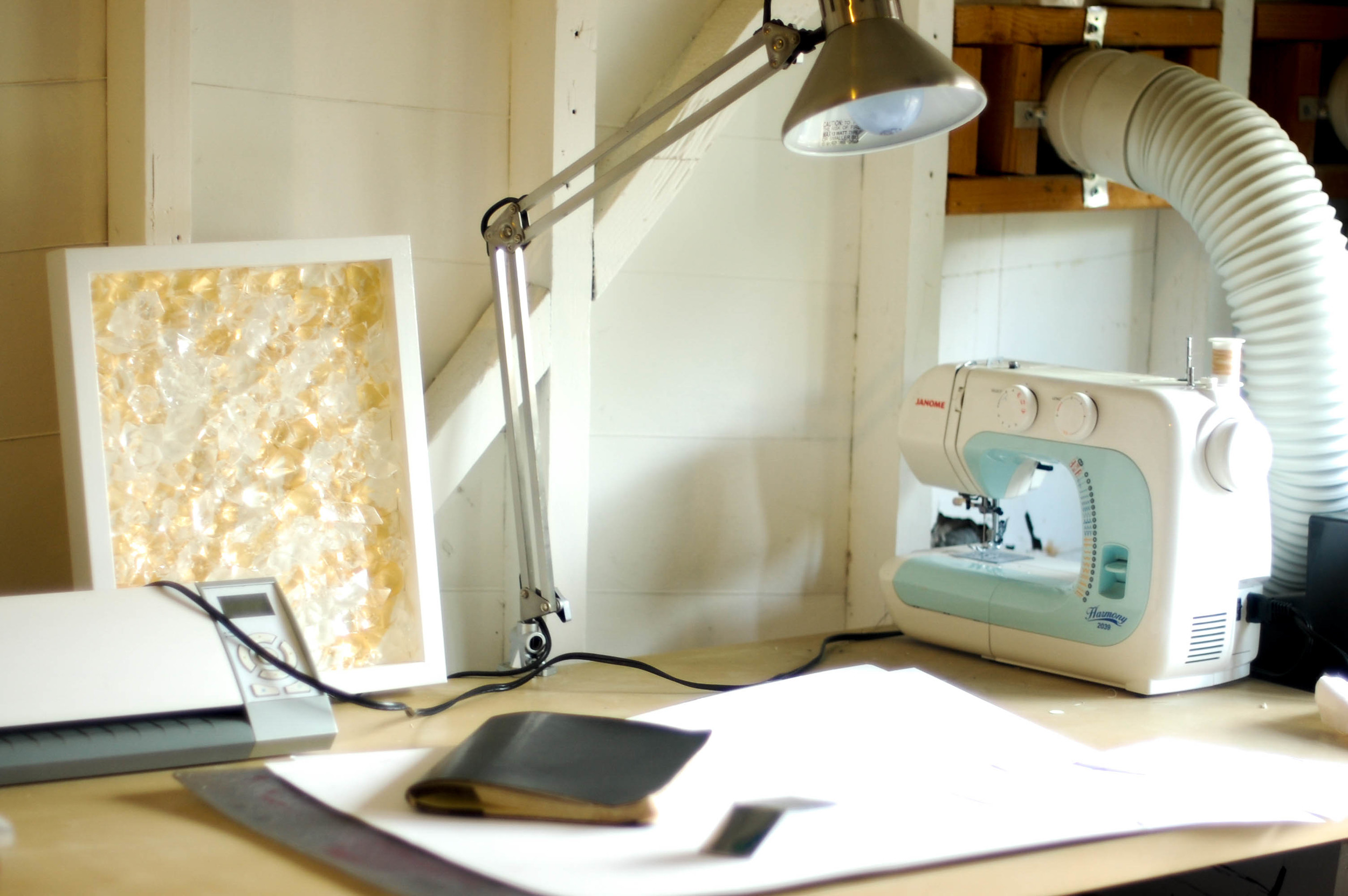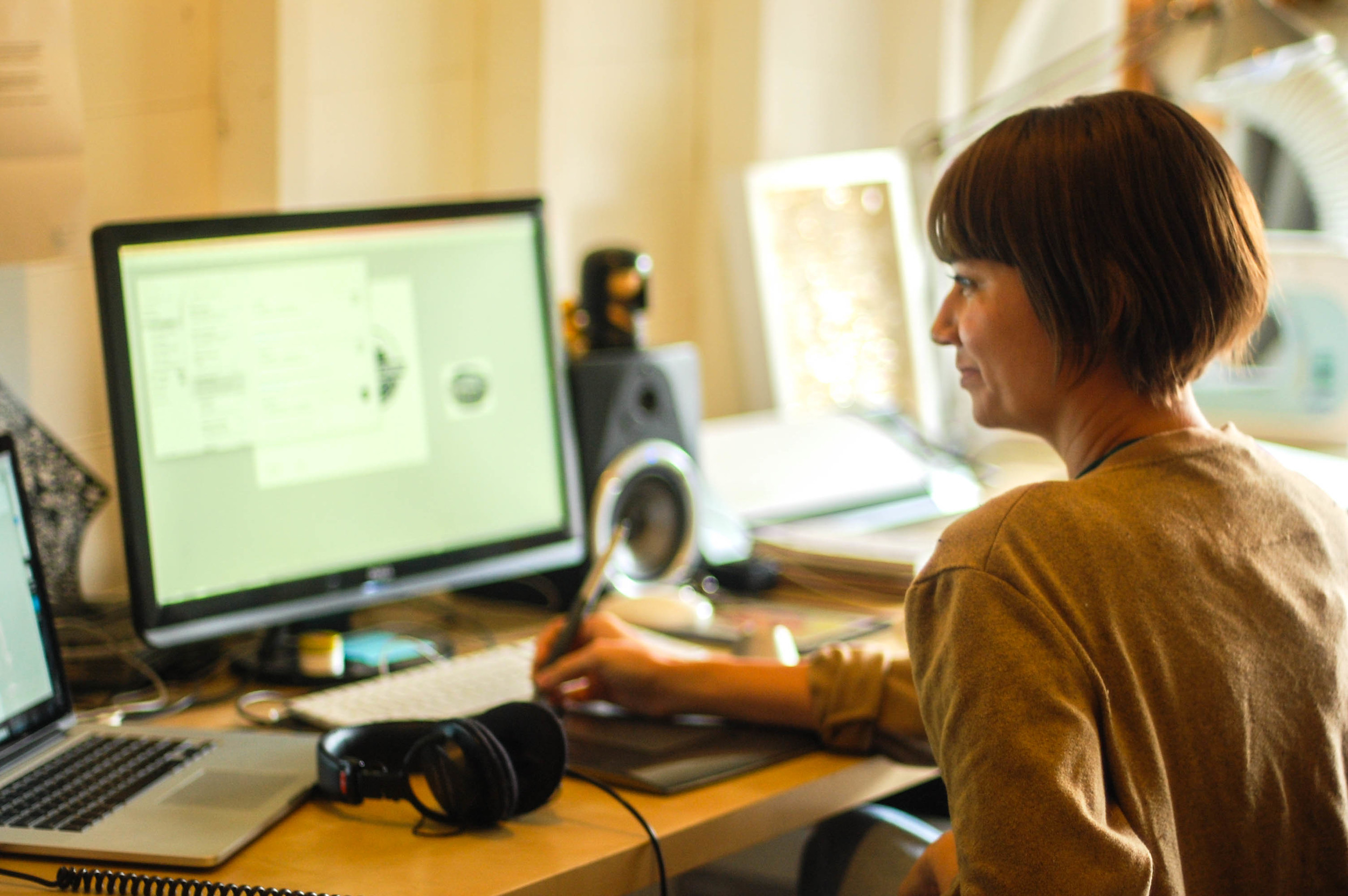



We thought we were busy in the Art Unified office. However, after sitting down with Art Unified artist Paige Smith we've realized we're still in the productivity minor leagues. Smith - who also goes by her street artist name A Common Name - is not only a celebrated street artist, but an entrepreneur, creative director and freelance graphic designer. We were thankful we were able to catch Smith (who was just recovering from jetlag when we met up with her), during a break in her normally-hectic schedule. And it's no wonder that the market is in high-demand for this artist: Smith represents a rare, but growing, class of hybridized young creatives, whose adaptive problem-solving skills, unique artistic sensibilities and a gnarly work ethics have earned them both the attention of the art world and the empowerment to direct that attention. Her Urban Geode work has taken street art to a new level, with its three-dimensionality and participatory aspect. As a result, these Urban Geodes are now popping up in nooks and crannies all around the globe. Read on to see what Smith had to say about making the move from San Francisco to Los Angeles, Parisian street artist JR, and what it takes to be a successful creative entrepreneur (hint: it involves a lot of heavy lifting).
"There's an energy that I've never felt before. There are so many creatives in this city, and everybody's here to make it. It's really inspiring."
Art Unified: Tell me a little about yourself. Let's start with your schooling - did you study art in elementary school or in high school, or did it begin with secondary education?
Paige Smith: I started pretty young. I was always entering - do you have URL? It's this yearly competition, like in reading, but also in arts. I would always enter the arts competitions. And, actually, in fifth grade I won a greeting card contest. It was really nerdy.
I took art art classes in middle school, but I stopped in high school because I became part of the band. It's really hard to do more than one art, which is interesting. But then, in college I started up again. My degree is in Graphic Arts and Design Communications. To have that degree, you have to take a lot of fine arts classes. So I have a wide breadth of multimedia work. I took a lot of ceramics classes because I really love working with my hands - that's always been the case for me. I don't really like drawing for hours - I wish I did though.
AU: So, in our conversations before, you've mentioned that you've lived in other cities, so can you trace your route from college to Los Angeles?
PS: I grew up in Texas, and then I went to Texas Tech University, which is in Lubbock, Texas - very out in the middle of nowhere. Over the years, I realized that Texas really wasn't for me, and I wanted to try something new. I had friends moving to San Francisco, and I tagged along. I had never been there. I just picked up all of my stuff the day I finished class, and drove across the country to San Francisco. I just moved into this little apartment, sleeping on a couch, and I ended up living there for 5 years and having this whole life - I grew so much. And then from there, I decided to move to Los Angeles. I was a freelance graphic designer and I was just ready to move on. I knew that LA was a really big city in this world, and I really love California, so it was really appealing for me to jump in that atmosphere. I've been here for almost 5 years now.
AU: So do you have plans for moving on from Los Angeles?
PS: No, not for a long while. I think eventually, but I'm really loving it here. There's an energy that I've never felt before. There are so many creatives in this city, and everybody's here to make it, and I really love being surrounded by that. It's really inspiring. Even though I'm sure there are many other cities that have that to offer, especially New York, I think this city has been kind to me. I love it. I think it's a great place to stay and make roots, and to really build what I've started.
AU: So then, you mentioned your degree in graphic arts. So, aside from the artist personality A Common Name, what takes up your professional time?
PS: I'm still designing and I have my other company Vere Verto, which is a handbag line.
"I hear so many people that are worried and who ask, 'What do I do?' And I just say, do it. Just. Do. It. That's so cheesy, but just fucking sit there and do the work. Don't think about it."
AU: Can you tell us about Vere Verto?
PS: I came up with the idea while living in San Francisco. I rode my bike every single day. And if I wasn't riding, then I was taking the bus or the Metro. I realized there was a giant problem with awesome bags that weren't just backpacks, that made you look like a turtle everyday. It snapped in my head that I needed to create a nice bag that was able to convert that was able to be both. That festered inside me for years. By the time I moved here, I had kept on meeting people in fashion or related to fashion, and I was inspired by the fashion here. It took root again, and I just started the company with a friend. It's been in operation for one year. We were developing for a year beyond that, but it's been great. Every goal that we've set for ourselves has made it, but it's definitely a slow and steady course for us.
AU: One thing we're interested in implementing more into the Art Unified blog is this new hybrid figure of artist, entrepreneur and freelancer. How do you go about managing your schedule between these three things, and is there any sort of gray area between those three camps that allows you to maximize your time?
PS: That's a really great question - that's the thing I struggle with most in my life right now. I have three jobs. They're all within a design and art place, so one can influence the other very easily. For instance, I do all of the creative direction for Vere Verto - all of the design work. That helps inform the work on the other side, and it utilizes my talents. The bags themselves are a result of product design, which reflects my interest in hand-building things, which is also where the geodes come in. I feel like I'm always solving a problem. My art is site-specific - I'm solving a problem each time. That's what makes the pieces unique.
But, in terms of scheduling myself, it's a very difficult thing. I do end up working up to 14 hours each day, 7 days a week. But I have a passion for everything I do, and that drives me. I'm not sitting here pissed that I'm working. I'm just like, 'See you later world, I'm gonna lock myself up in my studio for a while.'
AU: So, just going off of that, do you have any words of advice to fledgling artists or entrepreneurs in a creative field? Like you mentioned earlier, everybody in this city is here to make it. It can be so daunting when you take a look at the competitor pool.
PS: My advice is to not worry about failing. You're going to, no matter what. It's that old adage, you're not going to succeed unless you fail. And you fail and fail and fail, and then just maybe finally make it. I hear so many people that are worried and who ask, 'What do I do?' And I just say, do it. Just. Do. It. That's so cheesy, but just fucking sit there and do the work. Don't think about it. It's one thing I do not have time to do is sit there and worry. I decided to do the geodes and they're not going to happen without me sitting down and actually doing the work. The more I did the work, the more things came to me. If there is a problem, I don't freak out - I just fix it. All you can do is find the solutions that will help you get to the next place.
I realize I'm becoming less and less of an emotional person, and more of a fixed problem-solver. I think that really helps you keep moving forward and building more work. Sometimes you can get stunted by those thoughts like, 'What do I do next?' But if you just sit down and force yourself to move forward, you'll find something.
AU: Was there anything else you wanted to be while growing up? Did you ever think that you would be anything other than an artist?
PS: The only other thing I was interested in, which was not too far off, was architecture. I never thought I could be an artist, because I always felt that the world was too daunting for me. You come up with some kind of concept out of thin air? That was too much for me. But having design, where it's like - here's your idea. Here's your box. Grow on that, be creative there. Design really helped me in that way, and I feel like I've taken steps toward artistry.
I knew I wanted to be creative - I always knew that. But where and how? That's always come to me naturally through the steps I've taken. I never had a main goal, but happened upon everything.
AU: What artists inspired you as you were on your way to artistry? And who is most inspiring to you now?
PS: Hm, good question. Well, definitely always loved The Masters, of course. Anywhere I went, there wasn't a great push on contemporary art. I was definitely interested in Dali and surrealism. They inspired me so much. Now, as I've grown into what I've started doing, one of my most favorite artists is JR. He's everything all in one. His participatory art program is what inspired me to start doing that with urban geode, which is still in its fledgling, beta-testing program. He's major. I do find a lot of street artists that inspire me, like Swoon. I love Circle, because they're very design-oriented and I appreciate that. But they're also very physical and manifest more sculptural works more, which I like.
"That's always come to me naturally through the steps I've taken. I never had a main goal, but happened upon everything."
AU: So, you've lived in San Francisco, but you travel a lot. How would you say the Los Angeles art scene differs from art scenes around the world? Are there inherent negatives that are maybe tied to the city's geography and what are some of the positives of living and working here?
PS: I think in LA there are definitely negatives based off the geography. It's really nice to have Culver City. But with any other gallery, sometimes it's hard to want to go because it's so over there and nothing else is there. So you walk through, and you're done, and now you have to drive again. But people do it, they're used it. But I think that hurts the general public's desire to go to these openings, because it can be daunting. There's always a specific crew there, and you don't want to walk in and be the odd person. But like I said, there's a crazy energy right now. People are moving here - I can't even tell you how many New Yorker friends I have that just moved here. For New York, it's so easy to go to 10 shows in one night. Same with Istanbul. San Francisco... definitely has a scene, but I have to admit, I wasn't involved, I didn't go, and it wasn't inspiring. I hate to be that crude on it, but I came here and immediately was like, 'I wanna do art!'
There are a lot of murals in San Francisco - a lot of new ones, but also a lot of historic, Mission-based ones that are really great. Same here, but in LA the street art itself is blowing up. I think we're one of the main places - besides Philadelphia, which has like the most murals per square mile on the planet, which is amazing to see. But I think we're catching up. It's a really big deal here, and it's a reason I started what I've started. It's like a public gallery in Los Angeles, which is incredible. They take over billboards... where you don't expect to see a mural, you see something. It's really inspiring.
